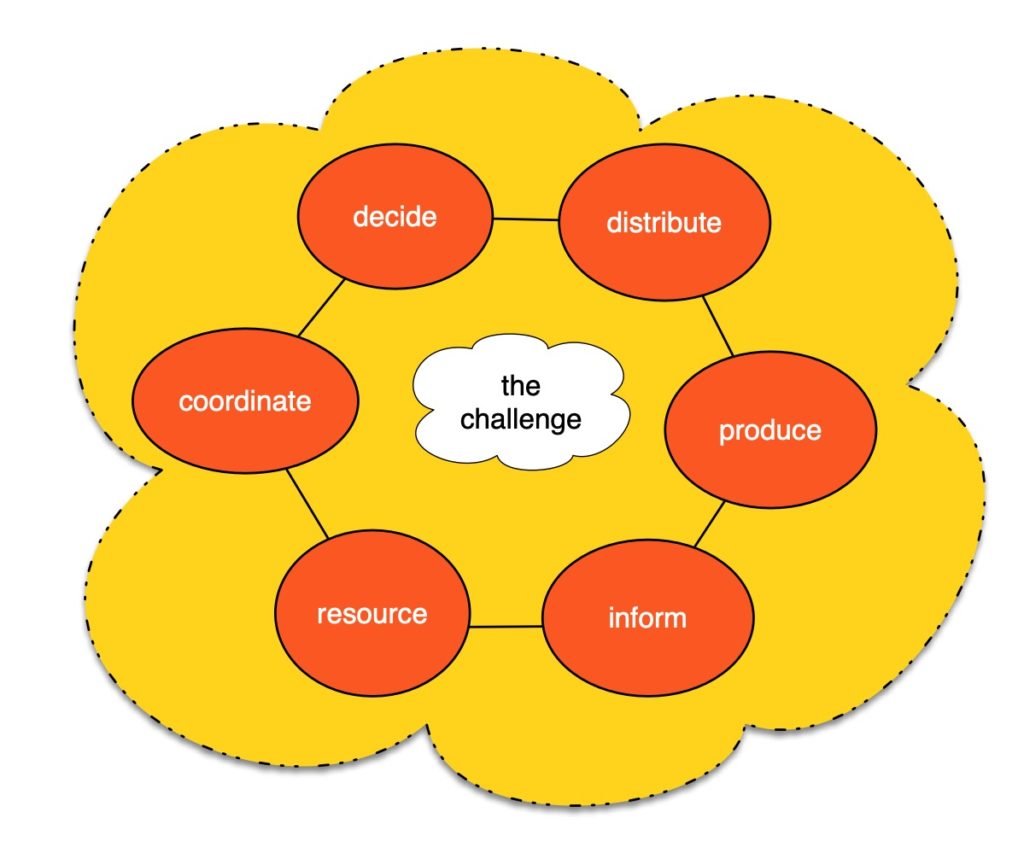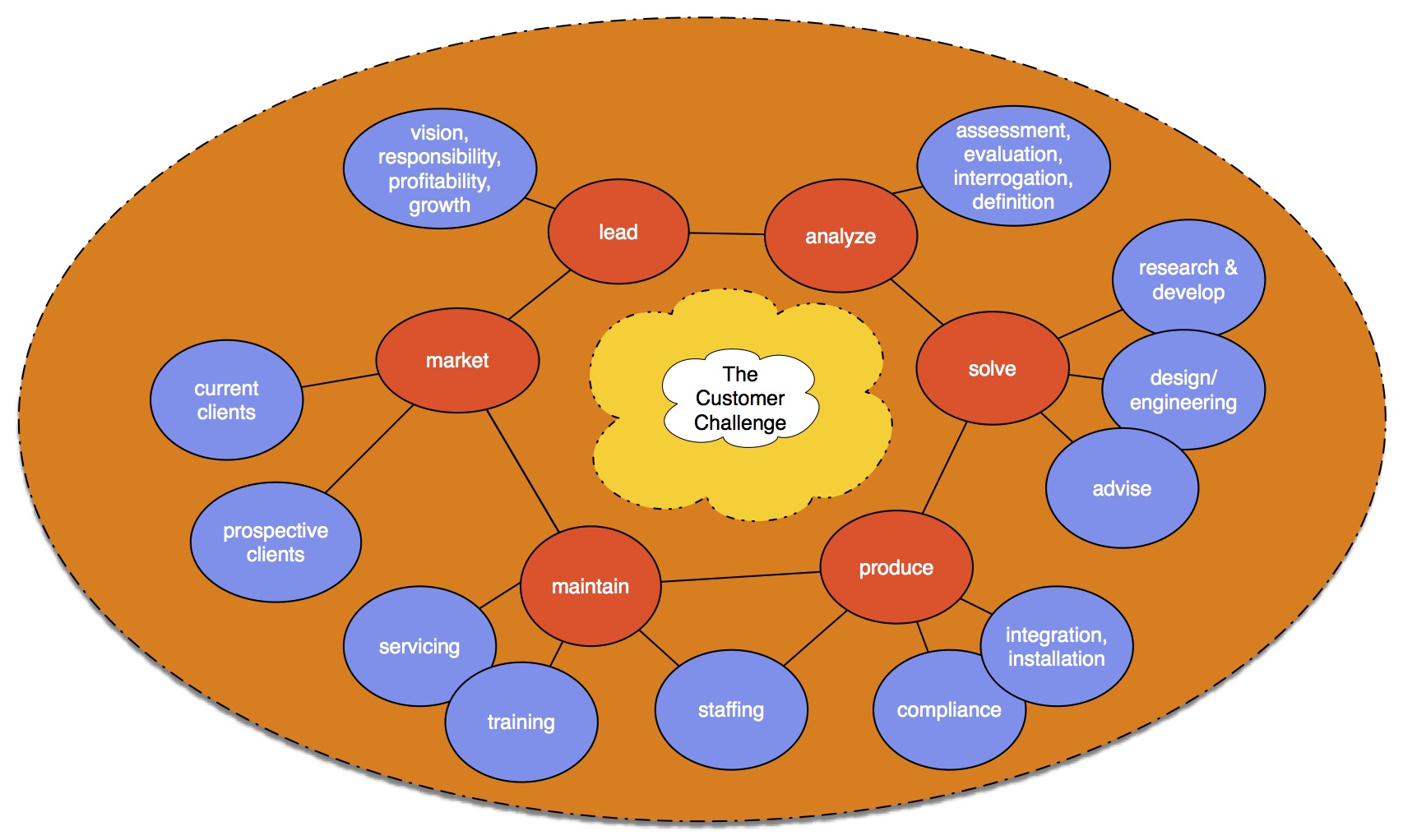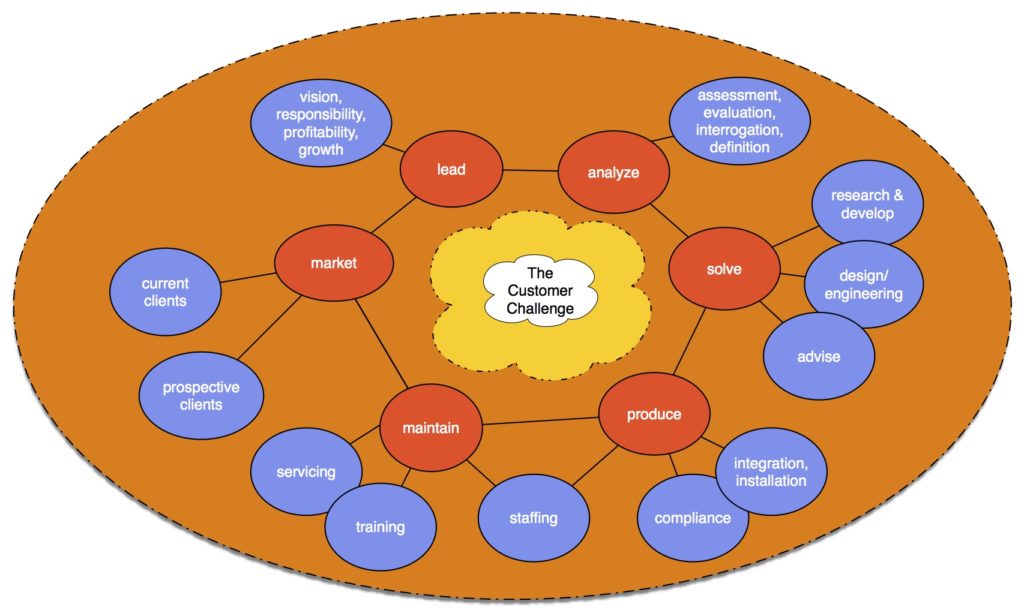
Organize meetings around actions rather than territories.
How to build a more productive team or host a more focused meeting.
True Confessions: The approach to organizing groups described here is not rooted in deep research or dozens of sociological studies (repeatable and not so repeatable). It is rooted in mere observation. Years of observation. Being a teammate. Sitting in meetings.
You know you’ve been part of a team that had too many members. Or members with individual agendas.
Many of those meetings were scheduled; some impromptu. Many promised agendas; most rambled. Some proved productive, far too many delivered only vague outcomes. At times, next steps were defined; but too often only loosely so.
In more instances than one cares to count, there have been 15 or more people sitting around a table, even lining the walls. And this heavily populated meeting is a reflection of the “team” assigned to deliver an outcome.
Think back. In nearly EVERY case, only five or six people truly contributed value to the topic. These few actors participated in discussion; they focused on the topic, they recognized the project or problem at hand; they proposed ideas, offered solutions, executed a task that contributed to that fabled synergistic whole. If you examined the scene, only a handful of participants truly made valuable contributions.
Out of this uncomfortable, but honest, observation comes an organizing principle for establishing participation in a team or meeting. Only on rare occasions should there be more than six people on a team or in a meeting.
Often there may be fewer; a minimum of 2, of course. There is no “I” in “Team.” There is also no “Team” in “I.” Yet there is always a “Team” behind any “I.”
Turn Attendance Into Action.
Invite only five or six people to join your team or attend your meeting. Invite more than that and you’re not holding a meeting, you’re holding a sit-in. It is a lecture and should be labeled as such.
Further, your team or meeting is more likely to deliver if it features one clearly defined challenge or problem. NOT a clunky list of loosely defined topics. Yes, the team should have an objective, the meeting should have an agenda. But the more vague the objective or the longer the agenda, typically the more parties get involved. It is almost always wiser to have more frequent, shorter, single-focus teams or meetings than a big omnibus gathering.
Teams and meetings are not spectator sports. Host single-topic, narrow time-frame teams and meetings that expect, even demand active participation from each member.
Turn Territories Into Interactions.
Another observation that drives this view is that in so so many situations, TERRITORY rules. Ego reigns over assignments and outcomes. Ego exerts influence to protect its territory. Territory requires boundaries, silo’d agendas, passive-aggressive barriers. Geography stifles cooperation and sterilizes collaboration. And even when engagement occurs, it tends to be governed by rules designed to preserve the boundaries, rather than deliver genuine interaction that advances a cause or addresses a purpose. Fiefdoms are walled off and while they may expand at first, ultimately, they become stale and may even lead to collapse.
RULE OF THUMB: FEWER VIEWERS. MORE DOERS.
Given these two key observations, a rule of thumb for roles in a meeting emerges: Fewer viewers. More doers. Turn down the observation. Ramp up the participation. Require each meeting to be guided by VERBs. Not by ego, territory or departmental geography. Limit your event to five or six smart people working together to meet a challenge or to solve a problem or to address whatever topic drove the call to meeting in the first place.
Verbs vs. Nouns. Active vs. Passive. Participate vs. Spectate. Do vs Be.
Imagine a traditional ad agency. The model provided the experiences that shaped this view of teams/meetings. Other business models will parallel the agency biz.
Like most businesses, the ad agency tends to be assembled in departmental chunks: account management, creative, media, operations. Today’s agency also boasts digital and social and data and analytics and project management and …. each is measured by head count, staffed with directors and managers and VPs and senior this’s and junior thats. The more department-oriented the challenge, the more members attend, the higher their status, the more attendees become auxiliary and some become outright outsiders.

Your Role: It’s What You Do More Than What You Are
Whoever you are, bring your verb to the table.
In this Five-Or-Six-Smart-People-Working-Together approach an agency can retain its organization, but must reboots its mindset. It can maintain its structure, but it must ramp up its energy level. Members are active, never passive. (Yes, there is listening, as long as it is active listening – that leads to thoughtful action. Silence needn’t indicate laziness or dis-engagement.)
How might an agency re-think the way it forms teams or arranges meetings in this approach? Let’s sample some verb-al explanations. Of course, you may assign/define your own verbs. As long as yes, you just do it.
Decide: Decision is the executive function. It is guided by vision, investment, connections, influence, ownership, etc. Its action is to decide, to sanction, to approve, to initiate, etc. It’s not kicking back or lording over. It’s actively playing a role in the process and the outcome. And if it’s not business ownership, then it’s someone who “owns” the challenge, project, relationship. etc. It is authority that is vibrant, clear and present, not remote or distant or foregone.
Focus: responsibility for the business, culture, goals; presence in the community (business and otherwise); and profitability.
Distribute: “I’m not attending because I’m a member of the media department. I’m attending because I have knowledge, experience, insights, ideas about the distribution of messages or content. I can activate the discipline I’ve cultivated in that area (un-oh geography!) in a discussion focused on meeting a challenge or solving a problem. I’m not just occupying a seat. I am active in the discussion, assertive, collaborative, engaged and engaging.”
Focus: identifying points of contact or interaction, media channels, planning/buying; from door hangers to chats, pixels to podcasts, Jellies to Super Bowls.
Produce: Allowing for a certain cringe-factor, this verb suggests the creative department. Its filter is development and execution. It’s engineering and manufacturing rolled into one. Perhaps. So the smart person representing this perspective is ready with what-ifs and how-tos to achieve possibilities. Never in isolation. Always in the context of the other dynamic inputs.
Focus: messaging; as in what to say, how to say it, how to make it … you know, the manufacturing arm of an agency.
Inform: This verb should probably appear first in the graphic. However in practice, discussions can start anywhere; participation is likely non-linear, filled with mixing, re-mixing and leap-frogging. A good meeting may only rarely be orderly, but that needn’t mean it lacks direction. Properly activated, this verb sets up everything else the meeting is meant to DO. Data, research findings, insights, definitions, competitive analysis, monitoring, whatever information can help guide strategy, suggest direction. All those static elements are brought to the table through this activity with the goal being to energize an active, collaborative endeavor.
Focus: research (qual, quant, ethno, BIG), account planning, analytics, KPIs, anything that has to do with preparing and then monitoring insights and effectiveness. Whew. Could be the most important verb.
Resource: Yeah … let’s make it an action verb. In a traditional sense, this verb correlates to “operations.” The CFO or the COO govern these territories. “Resourcers” bring “asset management” into the fray. What resources do we have (or not have) that can be activated to meet this challenge? This role demands realistic assessments, but in the true spirit of “getting things done,” it also must be liberated to think in terms of “what-ifs.” (See it’s creative, too!) What-if we move this resource over here? Or swapped out that asset for this one? What if we invest in this to generate that? Limits are opportunities in work clothes, to wrangle a phrase. They are not rigid barriers. They are invitations to think – and act – in new ways.
Focus: Everything it takes to OPERATE your business, from microprocessors to human processors. Big territory here, running silently in the background until providing license or asserting reality checks in a meeting or for a team.
Coordinate: Manage, handle, supervise, oversee … any of these “integrating” terms fit here. But the “Five-Or-Six” approach is not a top-down approach. It’s flatter, even “holocratic.” Meeting participants are self-managed equals. This verb might be about relationships, too, representing the owner of the challenge. At the end of the meeting, someone needs to own coordination of assigned or accepted activities and confirming outcomes determined by the group, sanctioned by, approved by a decider.
Focus: This verb is about actively representing the challenge your team is meeting. And may be active out there in the world finding the next challenge to overcome.
Do Your Own Thing.
Those six verbs are examples. The intent is to dramatize “doing;” each member of the meeting actively participating. Not hovering or feigning attention or just loitering around on the fringes. Take a penetrating look at how you organize meetings and see what verbs are not merely relevant, but are actually crucial to the business objective. Be alert to the role everyone PLAYS in contributing to the business objective. Of course, you may assign/define your own verbs.
So. What About The Smart Part?
Any member of the team or meeting who is actively engaged in contributing ideas, knowledge, insights, what-ifs is demonstrating smarts. Intelligence is not established by decree, degree or certification. It’s established through participation, through bringing focused, unexpected thinking to the mix. Re-mixing is a powerful problem-solver, making unexpected connections, layering knowledge from different disciplines (or verbs in this case).
The pool of actors a team may draw from to populate a meeting is dynamic. Not everyone available displays the same zeal for participation. The most productive outcome may be delivered by having some naysayers in the mix – as long as that player is engaged.
In any group, there are members who are on board; they’re believers in the cause or purpose, mission or goal. They’re probably easy to spot. And there are folks out on the fringe who may resist the business goal or culture. They may at moments appear almost hostile to those goals. These resistors may be waiting for some reason to move toward a belief — or move out entirely. These are not bad people. They may be motivated by the other factors. Test them to find out.
Then, of course, there are folks who oscillate between resisting and believing. They are testing the waters on both sides. They are valuable, too. (This diagram may reflect another way of looking at Pareto’s 80/20 Rule.)
You actually want this mix. If you build a team strictly out of believers, you facilitate echo chambers and group think — hot topics of late given the power of algorithms in social media (not to mention the human algorithm of comfort). But narrowing in or closing down exploration are very real issues today. Build your team or host your meeting to keep things lively, open — and active.
Beware of Experts.
Experts, by nature, are preservative/conservative. You may solve a new problem with an old solution. If so, all may be well, or just efficient. But you may often find your team seeking a new solution to a problem (long-standing or just perceived). Bring in the wild card member, an innocent, (a resistor or tester?), someone who represents a seemingly distance set of experiences. And invite surprise. The intent here is not to utterly discredit expertise. It is intended to question authority and avoid routine solutions.
“The difficulty lies not in the new ideas, but escaping the old ones.” — John Maynard Keynes
Just Do It.
No effort is required to be a noun. A little work, at least, is necessary to be a verb. To do. To act. After all, we are human beings. Human = noun. Being = doing. So if you want to avoid the lecture circuit and achieve something, pull your verbs together and get going.
Extras:
PS: Maybe this was a long way of echoing what they call, at Amazon, “two-pizza teams: a team that is small enough to be fed by two pizzas.” That reference provided by Tim O’Reilly in an EconTalk interview.
PPS: This “five or six” actor model could work in other industries. Just for kicks, check out the sketch below. It depicts how a network services firm might parse out a set of verbs/roles – rather than territories – to activate business structure, teams and/or meetings. In the true spirit of verbs: Go for it.

Different businesses, different verbs. But the same rules apply: Fewer Viewers. Only Doers. Actors, not spectators. Actions, not territories.
Recent Comments